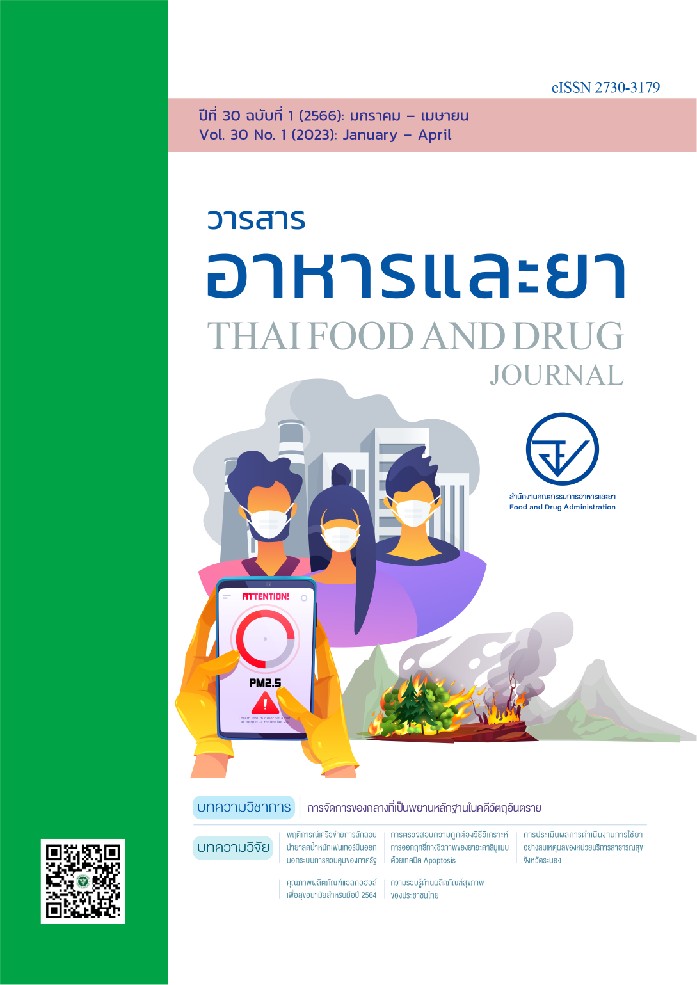คุณภาพของผลิตภัณฑ์แอลกอฮอล์เพื่อสุขอนามัยสำหรับมือที่จำหน่ายในประเทศไทยปี 2564
Main Article Content
บทคัดย่อ
ความสำคัญ: หนึ่งในมาตรการลดการระบาดของโรคโควิด-19 คืออนามัยส่วนบุคคลโดยเฉพาะการล้างมือบ่อย ๆ ด้วยการใช้ผลิตภัณฑ์แอลกอฮอล์เพื่อสุขอนามัยสำหรับมือ ทำให้ผลิตภัณฑ์ดังกล่าวเป็นสิ่งจำเป็นสำหรับวิถีชีวิตแบบใหม่ กระทรวงสาธารณสุขไทยจึงผ่อนปรนการควบคุมผลิตภัณฑ์ที่มีแอลกอฮอล์เป็นส่วนประกอบจากเดิมเป็นเครื่องมือแพทย์ให้เป็นเครื่องสำอาง ดังนั้นเป็นได้ว่าการจำหน่ายผลิตภัณฑ์ในช่วงวิกฤตินี้อาจพบความเข้มข้นของแอลกอฮอล์น้อยกว่าร้อยละ 70 โดยปริมาตรเป็นจำนวนมาก
วัตถุประสงค์: เพื่อศึกษาคุณภาพของผลิตภัณฑ์แอลกอฮอล์เพื่อสุขอนามัยสำหรับมือที่จำหน่ายในประเทศไทยในปี พ.ศ. 2564
วิธีการศึกษา: เป็นการวิจัยเชิงพรรณนา สุ่มเก็บตัวอย่างผลิตภัณฑ์แอลกอฮอล์เพื่อสุขอนามัยสำหรับมือตามแหล่งจำหน่ายทั่วประเทศแบบไม่ได้อาศัยทฤษฎีความน่าจะเป็นและเลือกตามความสะดวกระหว่างเดือนมิถุนายน ถึง สิงหาคม 2564 กำหนดขนาดตัวอย่างที่ 388 ตัวอย่างที่ระดับความเชื่อมั่นร้อยละ 95 แบ่งชั้นสุ่มตัวอย่างเป็น 5 ภาค ได้แก่ ภาคกลาง เหนือ ตะวันออก ตะวันออกเฉียงเหนือ และใต้ สุ่มเก็บตามพื้นที่ศูนย์วิทยาศาสตร์การแพทย์ 12 แห่งทั่วประเทศในจังหวัดต่าง ๆ รวม 31 จังหวัด สามารถเก็บตัวอย่างได้ทั้งสิ้น 411 ตัวอย่าง โดยมีสัดส่วนของประเภทตัวอย่างแบบเจล และแบบสเปรย์ไม่อัดแก๊ส 3 : 2 จากนั้นทดสอบทางห้องปฏิบัติการหาชนิดและความเข้มข้นของแอลกอฮอล์ 4 ชนิด คือ เอธานอล ไอโซโพรพานอล เอ็น-โพรพานอล และเมธานอล ด้วยเทคนิค gas chromatography นำผลมาเปรียบเทียบกับข้อกำหนดของประกาศกระทรวงสาธารณสุข
ผลการศึกษา: จากผลิตภัณฑ์แอลกอฮอล์เพื่อสุขอนามัยสำหรับมือที่สุ่มจากทั่วประเทศ 411 ตัวอย่าง เป็นเจลและสเปรย์จำนวน 280 และ 131 ตัวอย่าง พบว่าผลิตภัณฑ์ภาพรวมไม่ได้มาตรฐาน ร้อยละ 37.5 เป็นเจลและสเปรย์ ร้อยละ 41.1 และ 29.8 ตามลำดับ การจำหน่ายในพื้นที่ภาคกลางพบผลิตภัณฑ์ที่ไม่ได้มาตรฐานสูงสุด ร้อยละ 57.8 หากพิจารณาจากแหล่งจำหน่ายพบผลิตภัณฑ์ที่จำหน่ายในตลาดไม่ได้มาตรฐานสูงสุด ร้อยละ 56.3 สำหรับชนิดและความเข้มข้นของแอลกอฮอล์ที่ใช้ในผลิตภัณฑ์แอลกอฮอล์เพื่อสุขอนามัยสำหรับมือนั้น พบว่า ใช้เอธานอลเป็นส่วนประกอบสำคัญสูงสุด ร้อยละ 86.1 ความเข้มข้นที่พบอยู่ระหว่าง 2.5 - 89.3 % v/v แอลกอฮอล์ที่อนุญาตให้ใช้ชนิดอื่น ๆ รองลงมา คือ ไอโซโพรพานอล ร้อยละ 4.1 ความเข้มข้นที่พบอยู่ระหว่าง 2.3 - 83.8 % v/v และยังพบแอลกอฮอล์ที่อนุญาตให้ใช้มากกว่า 1 ชนิดในผลิตภัณฑ์ และที่สำคัญคือพบว่าผลิตภัณฑ์ที่จำหน่ายในภาคเหนือและภาคกลางที่มีการใช้เมธานอลอย่างเดียว ร้อยละ 0.7 (3 ตัวอย่าง) โดยความเข้มข้นที่พบสูงถึง 58.0, 65.0 และ 70.6 %v/v ซึ่งอยู่ในรูปแบบเจล นอกจากนี้ยังพบการใช้เมธานอลร่วมกับแอลกอฮอล์ชนิดอื่นร้อยละ 0.5 (2 ตัวอย่าง) ในภาคอีสาน ซึ่งกฎหมายไม่อนุญาตให้ใช้เพราะเป็นอันตรายกับสุขภาพ
สรุป: ผลิตภัณฑ์แอลกอฮอล์เพื่อสุขอนามัยสำหรับมือที่จำหน่ายในประเทศไทยในปี 2564 ยังคงมีคุณภาพไม่ได้มาตรฐานสูง โดยพบผลิตภัณฑ์มีชนิดและความเข้มข้นของแอลกอฮอล์ไม่ได้มาตรฐานในรูปแบบเจลมากกว่าสเปรย์ ดังนั้นผู้ผลิตควรศึกษาวิธีการและกระบวนการผลิต เลือกใช้แอลกอฮอล์ที่กฎหมายกำหนด ตลอดจนมีความตระหนักและรับผิดชอบต่อสังคม ในขณะที่ส่วนราชการควรสื่อสารสร้างความรู้และความเข้าใจที่ถูกต้อง ดำเนินการเฝ้าระวังคุณภาพของผลิตภัณฑ์ที่จำหน่ายอย่างต่อเนื่อง และดำเนินการกับผู้ผลิตที่จงใจละเมิดกฎหมายอย่างจริงจัง เพื่อให้ผู้บริโภคเกิดความมั่นใจ
Article Details

อนุญาตภายใต้เงื่อนไข Creative Commons Attribution 4.0 International License.
เอกสารอ้างอิง
กระทรวงสาธารณสุข. ประกาศกระทรวงสาธารณสุข (ฉบับที่3) พ.ศ. 2563 เรื่อง ชื่อและอาการสำคัญของโรคติดต่ออันตราย. ราชกิจจานุเบกษา ฉบับประกาศ เล่ม 137, ตอนพิเศษ 48 ง (ลงวันที่ 29 กุมภาพันธ์ 2563).
กระทรวงสาธารณสุข. ประกาศกระทรวงสาธารณสุข (ฉบับที่3) พ.ศ. 2563 เรื่อง รายการเชื้อโรคที่ประสงค์ควบคุมตามมาตรา 18. ราชกิจจานุเบกษา ฉบับประกาศ เล่ม 137, ตอนพิเศษ 48 ง (ลงวันที่ 29 กุมภาพันธ์ 2563).
กรมควบคุมโรค. ขอความร่วมมือประชาชนเคร่งครัดมาตรการ D-M-H-T-T-A อย่างต่อเนื่อง เพื่อป้องกันโรคโควิด-19[อินเทอร์เน็ต]. นนทบุรี: กรมควบคุมโรค; 2564 [เข้าถึงเมื่อ 28 ธ.ค. 2564]. เข้าถึงได้จาก: https://ddc.moph.go.th/brc/news.php?news=18373&deptcode= brc
กระทรวงพาณิชย์. ประกาศคณะกรรมการกลางว่าด้วยราคาสินค้าและบริการ (ฉบับที่ 1) พ.ศ. 2563 เรื่อง การกำหนดสินค้าควบคุมเพิ่มเติม. ราชกิจจานุเบกษา ฉบับประกาศ เล่ม 137, ตอนพิเศษ 28 ง (ลงวันที่ 4 กุมภาพันธ์ 2563).
กระทรวงสาธารณสุข. ประกาศกระทรวงสาธารณสุข พ.ศ. 2563 เรื่อง กำหนดลักษณะของเครื่องสำอางที่มีส่วนผสมของแอลกอฮอล์เพื่อสุขอนามัยสำหรับมือ ที่ห้ามผลิต นำเข้า หรือขาย. ราชกิจจานุเบกษา ฉบับประกาศ เล่ม 137, ตอนพิเศษ 54 ง (ลงวันที่ 9 มีนาคม 2563).
สำนักงานคณะกรรมการอาหารและยา. คำชี้แจงประกาศกระทรวงสาธารณสุข เรื่อง กำหนดลักษณะของเครื่องสำอางที่มีส่วนผสมของแอลกอฮอล์เพื่อสุขอนามัยสำหรับมือที่ห้ามผลิต นำเข้า หรือขายพ.ศ. 2563 [อินเทอร์เน็ต]. นนทบุรี: สำนักงาน; 2563 [เข้าถึงเมื่อ 28 ธ.ค. 2564]. เข้าถึงได้จาก: https://www.fda.moph.go.th/sites/Cosmetic/SitePages/Laws.aspx
สำนักงานคณะกรรมการอาหารและยา. แนวทางปฏิบัติและการแสดงฉลากเครื่องสำอางที่มีส่วนผสมของแอลกอฮอล์เพื่อสุขอนามัยสำหรับมือตั้งแต่ วันที่ 9 มีนาคม 2563 เป็นต้นไป (สำหรับผู้ประกอบการ) [อินเทอร์เน็ต]. นนทบุรี: สำนักงาน; 2562 [เข้าถึงเมื่อ 28 ธ.ค. 2564]. เข้าถึงได้จาก: https://www.fda.moph.go.th/sites/Cosmetic/Shared%20Documents/ alcohol/alcohol.pdf
British Standard institute. Chemical disinfectants and antiseptics - quantitative suspension test for the evaluation of bactericidal activity of chemical disinfectants and antiseptics used in food, industrial, domestic, and institutional areas - test method and requirement (phase 2, step 1) (BSEN 1276/ 2019) [Internet]. London: British Standard institute 2019 [cited 2021 Dec 28]. Available from: https://www.en-standard.eu/publicdoc/bs-en-1276-2019-chemical-disinfectants-and-antiseptics.pdf
Bonafide Research & Marketing PVT.LTD. Asia-Pacific hand sanitizer market outlook 2025 [Internet]. Gujarat India: Bonafide Research & Marketing PVT.LTD; 2021 [cited 2021 Dec 1]. Available from: https://www.bonafideresearch.com/product/200419964/Asia-Pacific-Hand-Sanitizer-Market-2025
Yamane T. Statistics: an introductory analysis. 3rd ed. New York: Harper and Row; 1973.
ศูนย์ความเป็นเลิศด้านการจัดการของเสียอันตราย จุฬาลงกรณ์มหาวิทยาลัย. รายงานฉบับสมบูรณ์โครงการศึกษาปริมาณและการใช้งานแอลกอฮอล์ในประเทศไทย [อินเทอร์เน็ต]. กรุงเทพฯ: องค์การสุรา; 2560 [เข้าถึงเมื่อ 28 ธ.ค. 2564]. เข้าถึงได้จาก: https://www.liquor.or.th/aic/detail/โครงการศึกษาปริมาณและการใช้แอลกอฮอล์ในประเทศ
วรรณพร ศรีสุคนธรัตน์. สารต้านจุลินทรีย์ที่ใช้ในบ้านเรือนหรือทางสาธารณสุข [อินเทอร์เน็ต]. นนทบุรี: สำนักงานคณะกรรมการอาหารและยา; 2558 [เข้าถึงเมื่อ 28 ธ.ค. 2564]. เข้าถึงได้จาก: https://www.fda.moph.go.th/sites/Hazardous/ Region_
Download/ คู่มือสารต้านเชื้อจุลินทรีย์ที่ใช้ในบ้านเรือนหรือทางสาธารณสุข.pdf
มูลนิธิเพื่อผู้บริโภค. ผลทดสอบเจลแอลกอฮอล์. ฉลาดซื้อนิตยสารออนไลน์ [อินเทอร์เน็ต]. กรุงเทพฯ: นิตยสารฉลาดซื้อ; 2563 [เข้าถึงเมื่อ 20 ก.ย. 2563]. เข้าถึงได้จาก: https://chaladsue.com/article/3420


